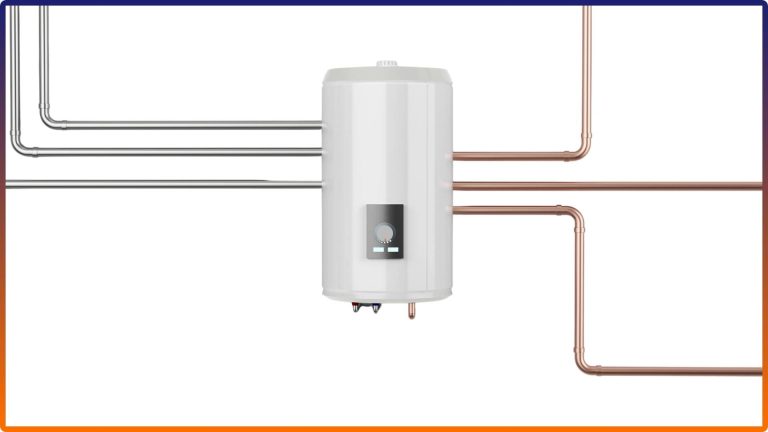How to adjust your water heater temperature: What is the best setting?
Reading Time Estimated: 4 minutes
Table of Contents
1. Introduction: Why water heater temperature matters
The temperature of your water heater is more important than you think. Water temperature is important for safety, comfort, cost, and lifespan. You may end up with lukewarm water in your showers if you set the water heater temperature setting too low. If you raise it, you run the risk of scald. This article will explain how to find the perfect balance, adjust your thermostat or dial, and what tradeoffs to be aware of.
2. Understanding Scald & Safe Ranges
What is a Scald
A burn is caused by hot water that causes a thermal injury to the skin. Scalds from tap water are more common than most people realize, particularly among older adults and children.
2.2 Burning Rates at Different Hot Water Temperatures
As water heats up, the Time required to cause serious burns (second or third degree) decreases. Here are some benchmarks that are often cited.
| Water Temperature | Time for Serious Burn* |
|---|---|
| 120 degF (49 C) | 5 Minutes or More |
| 125 degF (52 C) | 1 1/2 – 2 minutes |
| 130 degF (54 C) | 30 Seconds |
| 140 degF (60 C) | 5 Seconds |
| 150 degF (65 C) | 1-2 Seconds |
*These values are approximate; actual injury depends upon contact area, flow rate, duration and individual skin sensitivity.
Many guidelines recommend that water heaters be set at a lower temperature to prevent scalding.
3. Adjust your water heater temperature as recommended below
3.1 The 120-degree F is an ideal water heater temperature setting
The majority of safety authorities and manufacturers recommend setting the thermostat on your water heater to 120 degrees Fahrenheit. (about 49 °C).
This level:
- Significantly reduces the risk of serious burns (these can take up to several minutes).
- Most household appliances (showers and sinks) can be used without additional water.
- Mineral and scale accumulation can be reduced by reducing the amount of water used.
- Energy savings are possible because high temperatures cause more standby heat to be lost. The U.S. Department of Energy says that lowering the temperature from 140 degrees to 120 degrees can save 4-22 per cent on energy. Energy.gov is the Department of Energy website.
U.S. Consumer Product Safety Commission urges water heaters to be lowered to 120 degrees F to reduce injuries from scalding tap water.
3.2 Higher settings & Bacterial concerns
A potential negative of low settings is that they can encourage bacterial growth, particularly Legionella in water systems. To prevent bacterial growth, the CDC recommends that hot water systems keep stored water above 140 degrees Fahrenheit or not drop below 120 degrees Fahrenheit in circulating systems.
Some plumbing guides suggest that keeping the water at 60 degrees Celsius (140 degrees Fahrenheit) will help to control bacteria, and using mixing valves can reduce the temperature of the water at taps.
Experts generally believe that 120°F is safe for the majority of homes, unless there are immunocompromised occupants.
Balance Safety and Performance solutions to common water heater problems
Here’s how professionals find a balance because of the competing demands:
- Set the water heater temperature to 120°F.
- Install thermostatic mixing valves at fixtures or anti-scald devices to limit the outlet temperature further to safe levels. Use 120°F and lower, but allow higher temperatures if necessary.
- Monitor and flush your system regularly to limit bacteria growth.
- You can increase the base temperature if you want to (for dishwashers that don’t have built-in boosters, for example), but you should ensure you are mixing at the point of use.
4. Tanks and Tankless Devices: Adjusting the Temperature
4.1 Gas water heater temperature dial / control valve
Gas water heaters are controlled by a dial or knob that controls the temperature (usually located at the bottom of the tank).
To adjust:
- Find the dial (or gas control knob) (often marked “Vacation”, “Warm”, “Hot”, etc.). ).
- Turn the dial toward “Hot” or toward “Warm/Low” to reduce.
- Test the output if you don’t have exact numbers.
- Caution: Higher settings can increase scald risks.
- Consider installing mixing valves if you increase the temperature above 120°F.
4.2 Electric Tank Thermostats
In many electric tanks, there is one or two thermostats hidden behind the access panels (upper and below).
Steps:
- Shut off the power (circuit breaker).
- Carefully remove the insulation and access panels.
- Adjust both thermostats using a flathead screwdriver (i.e. 120 120°F).
- Reinstall insulation and panels. Then, turn on the power and wait until the system stabilizes.
- Test the output temperature of hot water from a faucet.
4.3 How to Set Up a Tankless Water Heater
Tankless Water Heaters are controlled via an electronic interface or digital control panel.
- You can set the temperature of the outlet on many units (e.g. 110 °F degF-140 110°F-140°F).
- Choose a moderate setting (e.g. to balance performance and safety, choose a setting between 120°F and 125°F.
- Tankless models have less standby losses than tanks because they heat water on demand.
- Some homeowners raise the temperature because they do not fear storage risk. Be cautious of scalding upstream.
After changing the setting, what should you do?
You can adjust the temperature of your water heater by adjusting it.
- Please wait for the water temperature to reach its maximum.
- A thermometer can be used to determine the temperature of hot water.
- If necessary, fine-tune the amount (increase or reduce).
- Mark the final setting of your dial/thermostat to make it easier for you to refer back next time.
- Monitor your thermostat periodically. The settings may drift over time, or the thermostat could wear out.
- Test all taps that children and the elderly use.
5. Special Considerations & Tradeoffs
5.1 Legionella & Bacterial Growth
The risk of Legionella is present when the temperature of hot water stored in water heaters is too low. According to the CDC, storage temperatures should be kept above 140 degrees Fahrenheit or at least circulating systems shouldn’t fall below 120 degrees Fahrenheit.
5.2 Energy Efficiency and Costs
The higher the temperature setting, the more heat is lost in standby mode. This means that heaters must maintain this high temperature constantly. According to the Department of Energy, lowering the temperature from 140°F down to 120°F will yield an annual energy saving of 4-22%.
According to one estimate, reducing the temperature of your hot water tank by 6-10% can reduce your water heating costs.
5.3 Compatibility of Appliances (Dishwashers etc).
For sanitization and to get the best performance from detergents, some appliances (especially older ones) require hotter water (130-140 degrees F).
Performance may be affected if your water heater has been set at 120 degrees F and the dishwasher does not boost temperature internally. In these cases:
- If available, use the dishwasher’s internal booster heating system.
- When needed, raise the temperature of your storage unit (e.g. overnight).
- You can also choose to use a hybrid method: Store at 125-130 degrees F, and then cool down the fixtures.
6. Comparison Table: Temperatures vs Risk vs Efficiency
| Setting | Scale Risk | Energy Use / Cost | Bacteria Growth Threat | Compatible with Appliances | Notes |
|---|---|---|---|---|---|
| 110-115 degF | Very low | Lowest Prices | You can also read about the following: | Too low for many uses | Showers that are lukewarm in temperature |
| 120 degF | Low (safe) | Low to moderate | Low-cost | Most people find it adequate | Highly recommended |
| 125-130 degF | You can also read about the following: | You can also read about the following: | Lower your prices | Good for dishwashers | Needs caution |
| 140 degF | High-quality | High-quality | Minimum | Strong for Sanitizing | High scald risks |
| above 140 degF | Very high | Very high | Minimum | Rarely needed | Extreme caution |
7. Best Practices and Troubleshooting Tips
- Regularly flush and maintain your tank and tankless water heaters to remove sediment, which reduces their efficiency.
- Install thermostatic mixer valves on faucets and showers to reduce burn risks.
- Consult the owner’s manual or instructions from the manufacturer when adjusting gas control dials on gas water heaters.
- Consider replacing or repairing your thermostats if the settings don’t match with actual output.
- Consider periodic “high heat flushes” for homeowners who are concerned about bacteria. You briefly raise the temperature above 140 degrees F, then flush your lines (only when safe).
- Label your thermostat or dial so that you can keep track of any changes over time.
Important Note
Setting the temperature on the water heater at 120 degrees Fahrenheit is a good compromise between energy efficiency and preventing scalds. Both safety agencies and manufacturers recommend this.
Conclusion
If you want hot water that’s reliable, safe and efficient, the best approach is to check and maintain the components and settings regularly.
Q1. What is the ideal temperature of a water heater in order to avoid scalding people?
It is common to recommend a setting of 120 degF( 49 °C). This reduces the risk of scalding while still delivering hot water.
Q2. Can I safely increase the temperature of my water heater to kill bacteria such as Legionella?
The higher the temperature (140°F), the greater the risk of scalding. It is safer to store hotter water at higher temperatures, if necessary, but to use mixing valves that limit the outlet temperature.
Q3. How can I adjust the temperature of my electric or gas water heater?
Use the temperature knob on the gas valve for a water heater. Switch off the power before adjusting the thermostats in electric tanks. Always test output after changes.
Q4. Do I have to be concerned about the energy costs associated with my hot water temperature setting?
Yes. Higher temperatures increase energy bills and standby heat losses. Savings of 4-22% can be achieved by reducing the temperature from 140 to 120 degrees Fahrenheit.
Q5. Does a tankless heater require the same care in temperature setting?
Absolutely. The tankless unit must have its outlet temperature controlled, even though it heats water on demand. This avoids the loss of storage space and reduces energy costs. The performance and comfort of the unit are also dependent on selecting an appropriate setpoint.


